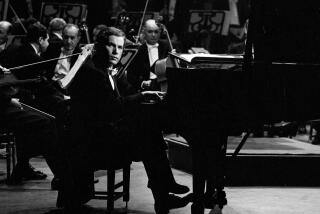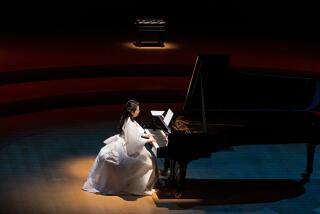FOUR PIANISTIC STYLES--ALL MADE IN AMERICA
The use of the expression “American pianist” to signify something more than place of birth came into existence during World War II, as did the career of William Kapell, a career tragically terminated in 1953 when the 31-year-old pianist was killed in an airplane crash.
It came to be generally understood that the archetypal American pianist was the possessor of limitless technique and a penchant for speed. He was, furthermore, a score-bound literalist and a purveyor--in the minds of the more conservative among the East Coast critics of the ‘40s and ‘50s--of “heartless” perfection. Such critics were fond, in their evaluations of American pianists, of employing a vocabulary drawn from the world of machine technology. Thus, a pianist’s “steely” fingers worked like “pistons” and “triphammers.”
Such a description, whatever its momentary appositeness, is preposterous as a judgment of Kapell’s playing, which we can again hear, with all the benefits of CD digital technology, in a Chopin program comprising the two mature sonatas and a dozen mazurkas (RCA 5998). It’s a marvel, from start to finish, of technique, interpretive intelligence and emotional power.
Words cannot adequately describe the subtle weighting of tone, the refined and delicate rubato he brings to the slow movements of both sonatas--the B-minor a studio job taped in 1951-52, the B-flat-minor a cherishable souvenir of Kapell’s last public appearance on Oct. 22, 1953, in Australia. He was killed a week later.
Yes, Kapell was born in the U.S.A. and yes, he did have “fingers of steel,” if by that we refer to his strength and accuracy. But they were by no means “pistons,” with the inhuman mechanical efficiency thereby suggested.
Two slightly younger American pianists, Leon Fleisher and Gary Graffman, both born in 1928 and both victimized in their primes by career-threatening hand ailments, fit the cliched description more closely. These are “tougher” pianists than Kapell, less preoccupied with tone than with textural clarity and textual fidelity. Their sound (not that they constitute a single “Fleishergraffman” entity) as it comes across in CD reissues is leaner, more tautly inflected, their notion of rhythm more straightforward than Kapell’s.
And they are not given to Kapell’s sometimes precipitous tempos on these particular recordings. But then neither is on his own, both being heard in concertos: Fleisher in the celebrated 1960-61 set of the Five Beethoven Concertos with George Szell and the Cleveland Orchestra, along with the Mozart Concerto in C, K. 503 (CBS 42445, three CDs); Graffman in his mid-1960s Rachmaninoff Second Concerto and Paganini Rhapsody, with Leonard Bernstein conducting the New York Philharmonic (CBS 36722).
The Graffman coupling might be considered a corrective to the once-prevalent swooning approach to the much abused Rachmaninoff works: intelligent, animated efficiency replacing sluggish sentimentality.
The Fleisher-Szell Beethoven can sound hard-boiled, as in the outer movements of the Second Concerto; rhythmically cramped and rather small-scaled in the “Emperor.” But in the Third Concerto and above all in the Fourth, the performers’ inherent coolness is tempered by a becoming broadening of tone, tempo and rhythm.
Still, these are hardly effusive readings--and the Mozart performance might best be described as “stark.” But for those in search of Classical Beethoven, that is, played in a lean, logical and penetrating style, Fleisher-Szell-Cleveland is the place to go.
Van Cliburn (born 1934), who abandoned his career after only a decade for reasons he has never cared to reveal fully, while by no means a mannered interpreter was nonetheless a throwback to an era of more Romantic, crowd-pleasing performers.
The latest of Cliburn’s CD reissues (RCA 6209) brings back his broad yet powerfully rhythmical, beautifully shaped reading of Rachmaninoff’s Third Concerto, with Kiril Kondrashin conducting the Symphony of the Air. The original recording was taped in concert at Carnegie Hall in 1958 just weeks after the pianist’s sensational triumph at the Moscow Tchaikovsky Competition. It is coupled here with the 1960 studio recording of Prokofiev’s Third Concerto, in which Walter Hendl conducts the Chicago Symphony.
It would be interesting to have on hand Kapell’s version of the Prokofiev, which, if memory serves, was one of those incredibly brilliant, aggressive interpretations that, unlike Cliburn’s, fits the “American pianist” stereotype. Cliburn’s Prokofiev is a quite marvelous combination of Old World, old-time grandeur and New World muscle: a gloriously big interpretation that, more than any other version on recordings, discloses Prokofiev’s roots in a Romantic tradition he claimed in the 1920s to abhor but was never able to banish from his own work as pianist or composer.
More to Read
The biggest entertainment stories
Get our big stories about Hollywood, film, television, music, arts, culture and more right in your inbox as soon as they publish.
You may occasionally receive promotional content from the Los Angeles Times.










